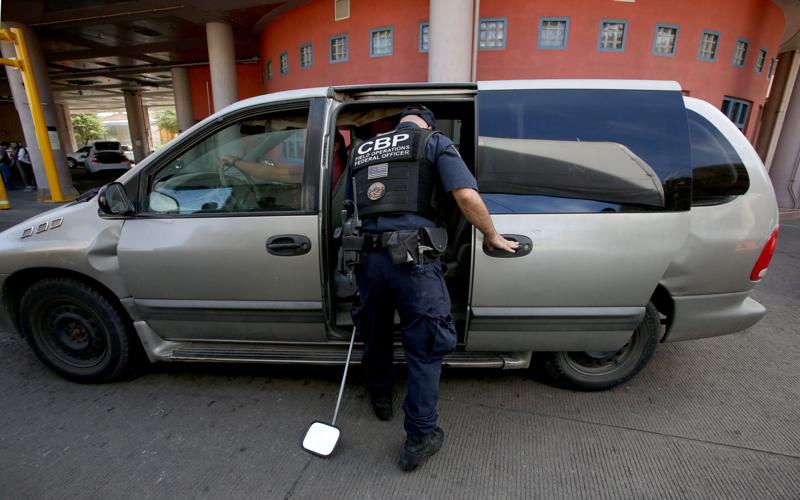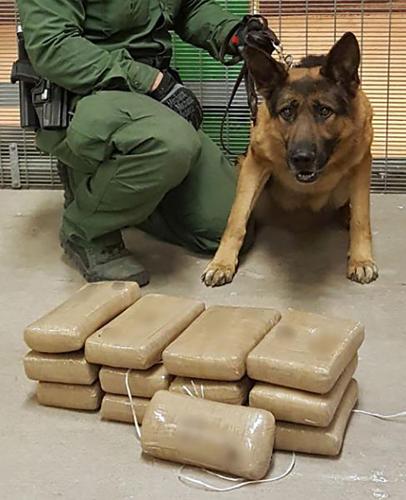Amid the daily traffic of workers, shoppers and truck drivers crossing the border on March 21, a customs officer in Nogales noticed a driver acting nervously.
A density meter and a drug-sniffing dog led customs officers to 2 pounds of cocaine, 15 pounds of heroin and 17 pounds of methamphetamine stashed inside the speaker box in the Chevrolet Malibu’s trunk, federal court records show.
Cases involving hard drugs seized at the U.S.-Mexico border regularly appear in U.S. District Court in Tucson. They also regularly appear in political rhetoric about border security and the opioid epidemic that has claimed tens of thousands of lives in recent years.
On April 24, President Trump tweeted: “The Wall is a very important tool in stopping drugs from pouring into our country and poisoning our youth (and many others)! If the wall is not built, which it will be, the drug situation will NEVER be fixed the way it should be!”
While Trump proposes building a wall to stop drugs from crossing the border and hiring thousands more Border Patrol agents, U.S. Customs and Border Protection statistics obtained by the Arizona Daily Star through a public-records request suggest the rhetoric coming from the White House reflects a misunderstanding of how and where hard drugs cross the border.
CBP statistics show 81 percent of the 265,500 pounds of hard drugs caught at the U.S.-Mexico border from fiscal year 2012 to fiscal year 2016 were stopped by customs officers at ports of entry, rather than by Border Patrol agents working in the desert and wilderness between ports.
Hard drugs normally are not driven on remote roads or hauled in backpacks through the desert, where they would be stopped by Border Patrol agents or come up against a border wall, although court records show agents catch hard drugs at highway checkpoints, such as the 5 pounds of heroin hidden in a man’s pants March 28 at the Interstate 19 checkpoint.
A far more common scenario in federal court cases in Tucson involves stashing hard drugs in vehicle dashboards or strapping them under clothes and trying to smuggle them through ports of entry staffed by customs officers.
Customs officers stopped 86 percent of the heroin caught borderwide from 2012 to 2016, CBP records show. Borderwide seizures of heroin by customs officers rose from 2,480 pounds in fiscal year 2012 to 3,280 pounds in fiscal year 2016, while Border Patrol seizures rose from 400 pounds to 560 pounds.
The National Institutes of Health reported fatal overdoses from heroin in the United States rose sixfold from 2002 to 2015.
Seizures of meth at ports of entry along the Southwest border rose from 13,700 pounds to 35,800 pounds and the Border Patrol saw seizures of meth rise from 3,400 pounds to 8,200 pounds.
In addition to searching for cocaine, heroin and meth, customs officers in Arizona also handled the border crossings of 8.8 million personal-use vehicles, nearly 400,000 commercial trucks, and $23.7 billion in trade in fiscal year 2016, CBP records show.
At the same time, customs officers are “under-equipped to handle the workload and desperately need reinforcements,” Tony Reardon, president of the union that represents customs officers, wrote in an August op-ed for The Hill, a political website.
To address the “yawning staffing gap,” officers work overtime and the agency brings in officers from other ports on temporary assignments, Reardon wrote.
CBP has used other methods in recent years to keep traffic flowing, such as allowing border businesses to pay customs officers to work overtime. In Arizona, Mexican customs officers now inspect some trucks alongside their U.S. counterparts to speed crossings.
Despite customs officers playing a key role in stopping hard drugs at the border, as well as dealing with perennial staffing shortages, they often are overshadowed by other agencies when it comes to funding.
Trump issued two Jan. 25 executive orders to hire 5,000 more Border Patrol agents and 10,000 more Immigration and Customs Enforcement officers responsible for arresting and deporting people in the country illegally.
But the executive orders did not mention hiring more customs officers. Nor were customs officers mentioned in Department of Homeland Security Secretary John Kelly’s Feb. 20 memos implementing Trump’s executive order or the president’s March 16 budget blueprint.
The 2017 federal spending bill signed into law last week increases Border Patrol staffing but does not mention customs officers, according to a summary from the House Appropriations Committee.
Meanwhile, Arizona’s congressional delegation is working to fulfill a 2014 congressional mandate to hire 2,000 more customs officers.
Rep. Martha McSally, R-Ariz., whose district includes Douglas, proposed a bill April 27 to address the staffing shortage of more than 1,000 customs officers and 1,800 Border Patrol agents along the Southwest border. The bill would exempt law enforcement officers who have already passed a polygraph examination from retaking the CBP polygraph when applying to be a customs officer or Border Patrol agent.
In December, Sen. Jeff Flake, R-Ariz., introduced a bill to “boost manpower at strained ports of entry along the U.S. border” by eliminating obstacles to recruiting and retaining officers. Flake and fellow Republican Sen. John McCain introduced a similar bill in March.
Arizona’s congressional delegation “responded to the call” for more customs officers, but “it doesn’t resonate at the presidential level,” said Bruce Bracker, Santa Cruz County supervisor and longtime business owner in Nogales, noting the lack of funding for customs officers is “not unique to the Trump administration.”
Rep. Raúl Grijalva, D-Ariz., whose district includes Nogales, repeatedly pushed the Obama administration to hire more customs officers.
“We have a brand-new facility at Mariposa and we have lanes that are closed” because of a lack of staffing, Bracker said in reference to the $250 million renovation of Nogales’ Mariposa Port of Entry completed in 2014.
In the narratives told about the border, “people don’t think about the blue uniform” worn by customs officers, said Michael Fisher, chief of the Border Patrol from 2010 to 2015.
Part of the reason is Border Patrol agents are visible in communities as they drive on roads and make arrests, while customs officers are usually seen only at ports of entry, he said.
In addition, illegal immigration seen at ports of entry “pales in comparison to what Border Patrol does,” Fisher said.
At Arizona ports of entry, officers stopped about 12,000 people who were deemed inadmissible in fiscal year 2016, while Border Patrol agents in Arizona apprehended about 65,000 people crossing illegally.
Although hard drugs are most often seized at ports of entry, Border Patrol agents outpace customs officers when it comes to finding marijuana. Border Patrol agents found 9.48 million pounds of marijuana at the Southwest border from fiscal year 2012 to fiscal year 2016, compared with 2.36 million pounds found by customs officers, records show.
The trend of smuggling hard drugs through ports of entry evolved in the past 20 years as smuggling between ports became harder because of surveillance technology and agents “getting smarter,” Fisher said.
“Smugglers were pushed further and further into rural areas,” he said, which meant expensive loads of hard drugs were exposed for hours or days during the crossing.
“It was too much of a risky proposition” and smugglers turned toward ports, where loads could cross in minutes amid thousands of other vehicles and pedestrians, he said.




